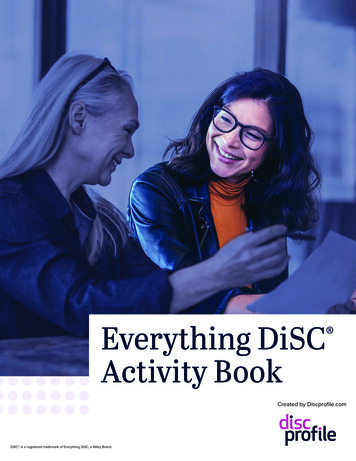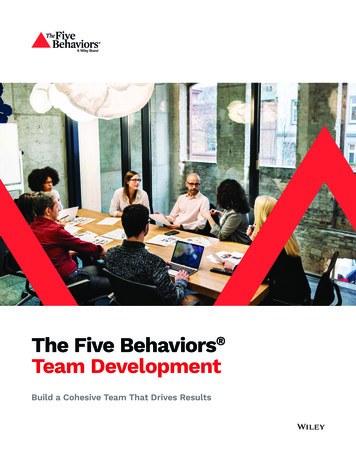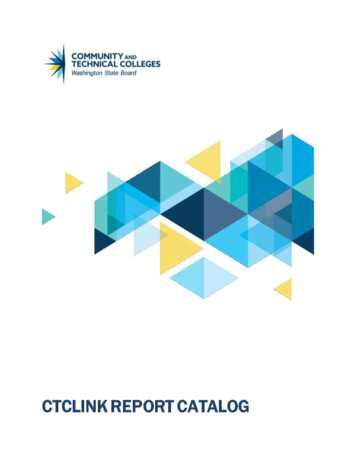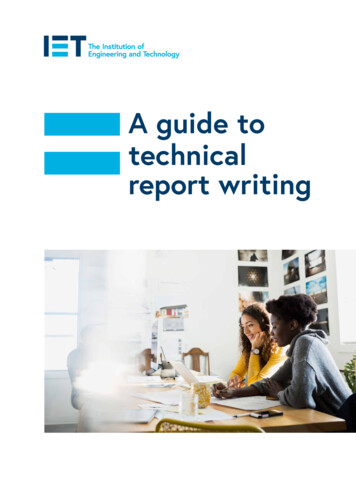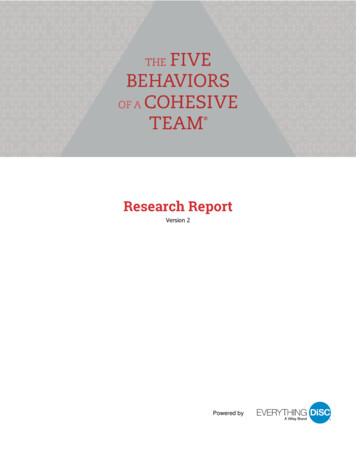
Transcription
Research ReportVersion 2Powered by
The Five Behaviors Research ReportTable of ContentsOverview of This Research ReportThe Five Behaviors Model . 5Part 1: Overview of the Validation ProcessReliability 6Stability . 7Internal Consistency 7Validity 8Part 2: The Individual Assessment: Everything DiSC Overview . 9Team Development . 9Personal Development .9The DiSC Model 10The Individual Assessment: Response Format and Style Assignment . 11Validation of the Individual Assessment 13The Individual Assessment: Reliability . 13Stability . 13Internal Consistency . 14The Individual Assessment: Validity . 16Scale Intercorrelations . 16Multidimensional Scaling (MDS) 18The Dimensionality of the Circumplex DiSC Model: Factor Analysis . 20Correlations with Other Assessments of Personality . 22Summary of the Validation Results . 28Copyright 2014 by John Wiley & Sons, Inc. All Rights Reserved.2
The Five Behaviors Research ReportPart 3: The Team AssessmentPsychometric Development 29The Five Behaviors Scales . 29Sample .30Sample Characteristics 30Impact of Ethnicity 32Descriptive Statistics: Team Survey . 33The Team Assessment: Validation Process . 35Reliability: Evidence of Internal Consistency . 35Construct Validity: Scale Intercorrelations . 36Comparing Team Sizes: Small and Large Teams . 37Team Survey 37Team Culture 39Summary . 43Appendix A: Everything DiSC Assessment Sample Demographics 45Appendix B: Everything DiSC Assessment Gender Differences . 46Appendix C: Everything DiSC Assessment and the 16PF . 47Appendix D: Everything DiSC Assessment and the NEO-PI-R . 49Appendix E: Team Culture Items for the Beta Sample 50Appendix F: References . 53Copyright 2014 by John Wiley & Sons, Inc. All Rights Reserved.3
The Five Behaviors Research ReportOverview of This Research ReportThe purpose of this report is to provide the validity research for The Five Behaviors of a CohesiveTeam assessments and related profile reports.The Five Behaviors of a Cohesive Team program consists of two main applications: PersonalDevelopment and Team Development. The Personal Development profile provides personalizedfeedback to help individuals become better teammates within the framework of The FiveBehaviors model. The Team Development application is intended to be used by existing teams toimprove their cohesiveness, productivity, and effectiveness. This team report includes personalizedfeedback for a team member along with feedback on the team overall.Both profiles require participants to take the Everything DiSC individual assessment. Participants’results on this assessment inform the personalized feedback they will receive in their profiles. Inaddition, participants involved in the Team Development application will also be required to answerquestions about their team in a second section, the team assessment; their answers in this section,along with those of their teammates, will inform the team results in their profile. Table 1 provides anoverview of these two assessments.This report provides validation research conducted on both the individual and team assessments.Table 1. Overview of lopmentEverything DiSCpersonality assessmentPersonalized feedback to help theindividual understand how theymight approach each behaviorIncludes:Feedback on how the teamapproaches each behaviorTeam DevelopmentTeam AssessmentUse of Results in FiveBehaviorsApplicationTeam Development Copyright 2014 by John Wiley & Sons, Inc. All Rights Reserved.Survey of the team’scurrent behaviorsSurvey of opinions onteam culture4
The Five Behaviors Research ReportThe Five Behaviors ModelThe Five Behaviors of a Cohesive Team is based on the model developed by Patrick Lencioni inhis book, The Five Dysfunctions of a Team. Lencioni’s model outlines the five behaviors that areessential to a healthy, well-functioning team: building trust, mastering conflict, achievingcommitment, embracing accountability, and focusing on results. These five behaviors build uponone another as follows: Members of a truly cohesive team must trust one another in order to engage in unfilteredconflict. They must engage in conflict so that they can commit to decisions and plans of action. Once team members are committed, they hold one another accountable for deliveringagainst those plans. After holding one another accountable, they focus on achievement of collective results.This model serves as the foundation for both the Personal Development and Team Developmentprofiles and will be referred to throughout this report.Copyright 2014 by John Wiley & Sons, Inc. All Rights Reserved.5
The Five Behaviors Research ReportOverview of the Validation ProcessPsychological instruments are used to measure abstract qualities that we can’t touch or see. Theseare characteristics like intelligence, extraversion, or honesty. So how do researchers evaluate theseinstruments? How do we know whether such assessments are actually providing accurateinformation about these characteristics or just generating haphazard feedback that soundsbelievable? Simply put, if an instrument is indeed useful and accurate, it should meet a variety ofdifferent standards that have been established by the scientific community. Validation is the processthrough which researchers assess the quality of a psychological instrument by testing theassessment against these different standards. This report is designed to help you understand thesedifferent standards and see how the Five Behaviors assessment performs under examination.Validation asks two fundamental questions:1. How reliable is the assessment? That is, researchers ask if an instrument measures in aconsistent and dependable way. If the results contain a lot of random variation, it is deemedless reliable.2. How valid is the assessment? That is, researchers ask if an instrument measuresaccurately. The more that an assessment measures what it proposes to measure, the morevalid the assessment is.Note that no psychometric assessment is perfectly reliable or perfectly valid. All psychologicalinstruments are subject to various sources of error. Reliability and validity are seen as matters ofdegree on continuous scales, rather than reliable/unreliable and valid/invalid on dichotomousscales. Consequently, it is more appropriate to ask, “How much evidence is there for the reliabilityof this assessment?” than, “Is this assessment reliable?”ReliabilityWhen we talk of reliability in relation to profiles such as The Five Behaviors of a Cohesive Team ,we are referring partly to the assessment’s stability and partly to its internal consistency.Copyright 2014 by John Wiley & Sons, Inc. All Rights Reserved.6
The Five Behaviors Research ReportStabilityStability refers to the assessment’s ability to yield the same measurements over a period of time.This is generally tested by having the same people complete the assessment twice, with a suitabletime interval between the two measurements (the so-called test-retest.) The results are thencompared to determine how strongly they relate to each other (or correlate.) If a person’s resultsremain unchanged, a stable assessment should produce results that are quite similar between twodifferent administrations. In reality, however, it is almost impossible to obtain perfect test-retestreliability on any sophisticated psychological test, even if the individual in question does not changeon the measured attribute. This is because test results are influenced by a variety of extraneousfactors that are unrelated to the characteristics that the test intends to measure. For instance,someone who is tired during one testing may answer differently than they will on a second testingwhen they are well-rested. Similarly, another person may respond to a test differently depending onthe mood they are in. Generally speaking, the longer the interval between two test administrations,the greater the chance that these random variables can artificially lower the test-retest reliability ofan instrument. In other words, the longer the time period between two testings, the lower we wouldexpect the test-retest reliability to be.Internal ConsistencyInternal consistency evaluates the degree of correlation among questions that profess to measurethe same thing. Researchers recognize that if all of the questions or items on a given scale are infact measuring the same thing, they should all correlate with each other to some degree. In otherwords, all of the items on a scale should be consistent with each other. A statistic called Cronbach’sAlpha is usually regarded as the best method of evaluating internal consistency.Cronbach’s Alpha expresses the degree of correlation as a specific number, which typically variesbetween 0 and 1.0. If the value of Alpha is 0, then there is no relationship among theitems/statements on a given scale. On the other hand, if all the statements in a questionnairemeasure in an identical fashion, then the value of Alpha will be 1.0, which indicates absoluteinternal consistency.Copyright 2014 by John Wiley & Sons, Inc. All Rights Reserved.7
The Five Behaviors Research ReportThe following guidelines are frequently used to evaluate the quality of a scale’s internal reliability:Alpha values above .70 are generally considered acceptable and satisfactory, Alpha values above.80 are considered quite good, and values above .90 are considered to reflect exceptional internalconsistency. In fact, Alpha values that are too high may indicate that the items on a scale areredundant or too similar. In such cases, many of the instrument’s items may provide very little newinformation about a respondent.ValidityAs mentioned, validity indicates the degree to which an assessment measures what it has beendesigned to measure. Assessing the validity of a psychological assessment that measures abstractqualities (like trust or dominance) can be tricky. There are, however, a number of basic strategiesthat researchers use to answer the question, “How well is this instrument measuring what it says it’smeasuring?” The validation strategies discussed in this report fall under the heading of constructvalidity.Construct validity examines the validity of an assessment on a highly theoretical level. A constructis an abstract idea or concept (such as intelligence, commitment, or influence) that is used to makesense of our experience. When researchers examine an assessment for construct validity, first,they specify a series of theoretical relationships (e.g., the construct A is theoretically related to theconstructs of X, Y, and Z). Then, they test these theoretical relationships empirically to see if therelationships actually exist. If the proposed relationships do exist, the instrument is thought to havehigher validity. Researchers test construct validity by looking at how two scales measuring distinctconstructs correlate to each other.Copyright 2014 by John Wiley & Sons, Inc. All Rights Reserved.8
The Five Behaviors Research ReportThe Individual Assessment: Everything DiSC OverviewThe personalized feedback for participants in both the Personal Development and TeamDevelopment applications is based on the results of their Everything DiSC assessment. Thissection of the research report gives an overview of the DiSC model and examines the validationresearch backing the assessment. Before reviewing the research, however, it will be useful tounderstand how each application uses the results of the Everything DiSC assessment.Team DevelopmentThe Team Development profile introduces the Everything DiSC model, explores the participant’sDiSC style (see the discussion of the styles in the pages that follow), and helps participantsunderstand how their style might influence their approach to each behavior in The Five Behaviors model. Most of the personalized feedback in the profile will therefore be written according to theparticipant’s style, which will be determined based on their responses in the Everything DiSCassessment. The profile also shows the DiSC styles of the other team members participating in theprogram, helps the participant understand how others might approach each behavior based on theirDiSC style, and gives all participating team members a common language to discuss theirsimilarities and differences.Personal DevelopmentAs with the Team Development profile, the personalized feedback in Personal Development isderived from the participant’s Everything DiSC assessment results. This feedback illustrates howthe participant might approach each behavior in The Five Behaviors model. The participant’s stylewill be determined based on their responses to the Everything DiSC assessment, and their stylewill inform most of the personalized feedback they receive in the profile.The Personal Development program does not, however, introduce participants to the DiSC model,and participants are never informed of their DiSC style. Instead, personalized feedback isprovided without reference to DiSC. This approach was possible because the assignment of aDiSC style, though helpful, is not essential to an understanding of the personalized feedback.Copyright 2014 by John Wiley & Sons, Inc. All Rights Reserved.9
The Five Behaviors Research ReportThat is, it is possible to provide feedback that speaks to the tendencies of each style withoutactually identifying the style or the model itself.Why did we choose to omit references to the DiSC model? The primary reason was to simplifythe profile and the related facilitation experience.* The Personal Development facilitationexperience is a half-day program, unlike the one- to three-day program associated with the TeamDevelopment application. By not making the DiSC model overt, the Personal Developmentapplication allows for more focus on The Five Behaviors model during the limited time frameavailable. That is, because participants are not required to understand the DiSC model tounderstand their profile, they can concentrate on The Five Behaviors model and theirpersonalized feedback.In addition, whereas the Team Development profile uses the DiSC model to help individualsdevelop trust with fellow teammates involved in the program, the Personal Development profile isfocused primarily on developing an individual’s teamwork skills. There is less need, therefore, toinclude the DiSC model within the framework of the Personal Development application.In sum, a participant’s DiSC style (as determined by their Everything DiSC assessment results)informs the Personal Development profile but functions largely in the background. In this way,participants can focus on The Five Behaviors model while still receiving personalized feedbackthat is backed by the research described in the pages that follow.The DiSC ModelThe foundation of DiSC was first described by William Moulton Marston in his 1928 book, Emotionsof Normal People. Marston identified what he called four “primary emotions” and associatedbehavioral responses, which today we know as Dominance (D), Influence (i), Steadiness (S), andConscientiousness (C). Since Marston’s time, many instruments have been developed to measurethese attributes. The Everything DiSC assessment uses the circle, or circumplex, as illustratedbelow, as an intuitive way to represent this model. Although all points around the circle are equallymeaningful and interpretable, the DiSC model discusses four specific reference points.*Note that the report can also be distributed independently of the facilitation experience.Copyright 2014 by John Wiley & Sons, Inc. All Rights Reserved.10
The Five Behaviors Research ReportDominance: direct, strong-willed, and forcefulFigure 1. Everything DiSC MapInfluence: sociable, talkative, and livelySteadiness: gentle, accommodating, andsoft-heartedConscientiousness: private, analytical, and logicalAlthough some people tend equally toward all of these regions, research indicates that most of uslean toward one or two. Each person who takes the Everything DiSC assessment is plotted on thecircle, also known as the Everything DiSC Map. The example in Figure 1 shows a person(represented by the dot) who tends toward the D region, but also somewhat toward the i region.This represents a Di style.This person, therefore, is probably particularly active, bold, outspoken, and persuasive, as thesequalities generally describe people who share both the D and i styles. The distance of the dot fromthe center of the circle is also meaningful. People, whose dots fall toward the edge of the circle, asshown in Figure 1, are much more inclined toward their DiSC styles and are likely to choose thepriorities of that style over those of other styles. People whose dots fall close to the center of thecircle are less inclined toward a particular style and find it fairly easy to relate to the priorities ofother styles.The Individual Assessment: Response Format and Style AssignmentThe Everything DiSC assessment asks participants to respond to statements on a five-pointordered response scale, indicating how much they agree with each statement. These responsesare used to form scores on eight scales (standardized to have a mean of zero and standarddeviation of one) that are located around the DiSC circle, as shown in Figure 2. The eight scalesare as follows: D measures a direct, dominant disposition using adjectives such as aggressive, strongwilled, and forceful.Copyright 2014 by John Wiley & Sons, Inc. All Rights Reserved.11
The Five Behaviors Research Report Di measures an active, fast-paced disposition using adjectives such as dynamic,adventurous, and bold. i measures an interactive, influencing disposition using adjectives such as sociable, lively,and talkative. iS measures an agreeable, warm disposition using adjectives such as trusting, cheerful,and caring. S measures an accommodating, steady disposition using adjectives such as considerate,gentle, and soft-hearted. SC measures a moderate-paced, cautious disposition using adjectives such as careful,soft-spoken, and self-controlled. C measures a private, conscientious disposition using adjectives such as analytical,reserved, and unemotional. CD measures a questioning, skeptical disposition using adjectives such as cynical,stubborn, and critical.During the assessment process, the respondent’s variance on each of the eight scales iscalculated. If the variance on a particular scale is above a predetermined cut-off, the participant ispresented with additional items for that scale. In this way, the assessment can gain more certaintywith regard to the respondent’s true score. This process mirrors those used in other adaptive testingassessments.An individual’s scores on the eight scales are then used to plot the individual on the EverythingDiSC map, as represented by a dot. The Everything DiSC map is divided into 12 sections, orstyles, each representing 30 degrees within the circle. Feedback is largely based on the section inwhich the dot falls. Other factors, such as the dot’s distance from the center of the circle and theindividual’s priorities, may also be reflected in the feedback.**Note that the eight scale scores are not directly reported in the profiles. In addition, the Personal Development report willnot include a visual representation of the Everything DiSC map or a description of a person’s DiSC style or dot location.Copyright 2014 by John Wiley & Sons, Inc. All Rights Reserved.12
The Five Behaviors Research ReportFigure 2. Eight DiSC ScalesValidation of the Individual AssessmentValidation is a process in which an assessment is reviewed for its overall reliability, whether it isconsistent and dependable, and its overall validity, whether it measures the construct accuratelyand is measuring what it is supposed to measure. For a more in-depth discussion of the completevalidation process, please see page 6.The Individual Assessment: ReliabilityReliability is the term we used to encompass the discussion of both an assessment’s stability andits internal consistency.StabilityThe Everything DiSC assessment’s stability was examined by determining if the assessmentproduced the same measurements over a period of time. In practical terms, the stability of DiSC(i.e., test-retest reliability) is measured by asking a group of respondents to take a DiSC instrumentand then asking those same respondents to take the same test again at a later time. This stabilitycan be quantified in the form of a reliability coefficient, which is a statistic that is generated bylooking at the mathematical relationship between a group’s initial scores on an instrument and theirsubsequent scores. Reliability coefficients range between 0 and 1.0. The closer that a correlationcoefficient is to 1.0, the more stable the instrument is considered to be. Researchers generally useCopyright 2014 by John Wiley & Sons, Inc. All Rights Reserved.13
The Five Behaviors Research Reportthe following guidelines to help them interpret these test-retest reliability coefficients—coefficientsabove .70 are considered acceptable, and coefficients above .80 are considered very good.The eight scales of the Everything DiSC assessment have been measured for their test-retestreliability over a two-week period and the following coefficients were found:Table 2. Scale Test-Retest 88C.85CD.85D.86N 599These results suggest that results produced by the Everything DiSC assessment are quite stableover time. Consequently, test takers and test administrators should expect no more than smallchanges when instrument is taken at different times. As the period between administrationsincreases, however, divergent results of these administrations will become more and morenoticeable.Note that even over very short intervals an instrument’s results can show small changes. In fact, itis unlikely that two administrations of a test will yield the exact same results on any sophisticatedpsychological instrument. When such changes are observed in DiSC , however, the fundamentalinterpretation of the results will usually be the same.Internal ConsistencyInternal consistency refers to the amount of correlation among questions or items that are said to bemeasuring the same thing. Cronbach’s Alpha is used to evaluate internal consistency. It typicallyranges from 0 to 1.0. Alpha coefficients were calculated for a sample of 752 respondents. TheCopyright 2014 by John Wiley & Sons, Inc. All Rights Reserved.14
The Five Behaviors Research Reportdemographics of this sample are included in Appendix A. The scales on the Everything DiSC assessment demonstrate good-to-excellent internal consistency, as shown by the Alpha valueslisted in Table 3. All reliabilities are well above .70, with a median of .87.Table 3. Internal Consistency of the Everything DiSC ScalesCronbach’s AlphaScaleNumber of 88DN 752Analyses were also performed to understand the impact of the extra adaptive questions that somerespondents receive if there is a large amount of variation within their responses to a single scale’sitems. That is, if the variance in a respondent’s ratings to a scale’s items is above a certain level, therespondent is given five to ten extra items that continue to measure the trait assessed by the scale.For convenience, the items that all respondents receive will be called “base items” and the items thatonly inconsistent responders receive will be called “extra items.”Table 4 shows the internal reliabilities for only those respondents who gave the most inconsistentresponses to a given scale’s items, measured by a high degree of response variance. In other words,these are respondents whose scale preferences seemed most unclear. In the first bold column are theAlphas for those respondents using both the base items and extra items (which reflects how theserespondents are measured in the actual assessment). In the second bold column are the Alphas forthose respondents using only the base items. With only the base items, the median Alpha in thissubsample is .62. The median Alpha when the extra items are included is .77. By comparing thesetwo columns, we can see the internal consistency is much higher for these unclear respondents whenthey receive the extra items. In essence, these extra items are used to further gauge the target traitwhen the normal assessment has produced unclear or variable results. The final column shows theCopyright 2014 by John Wiley & Sons, Inc. All Rights Reserved.15
The Five Behaviors Research Reportpercentage of respondents in the sample who received extra items on a given scale. On average,24% of respondents received extra items on an individual scale.Table 4. Internal Consistency of the Everything DiSC Scales for Inconsistent RespondersWith extra itemsWithout extra itemsAlphaN# itemsAlphaN# items% receivingextra 1613.34116815%ScaleThe Individual Assessment: ValidityValidity examines whether an assessment is measuring the construct or idea that it says it ismeasuring. Researchers look at a number of different things to determine the assessment’s evidencefor validity. For the purposes of the Everything DiSC assessment used in both Personal Developmentand Team Development, construct validity and scale intercorrelations are used.Scale IntercorrelationsBecause DiSC is based on a theoretical model, certain relationships are expected when looking atthe different scales. The Di scale of the Everything DiSC assessment, for example, measures aparticular construct (i.e., the tendency to be bold, adventurous, and fast paced). This “bold” construct,in turn, is theoretically related to a variety of other constructs. For instance, it is reasonable to assumethat someone who is very bold will not be particularly cautious in nature. Thus, bold tendencies andcautious tendencies are theoretically linked in a negative manner. Consequently, we would expectthat people scoring high on the Di scale should score relatively low on a scale measuringcautiousness, such as the SC scale.Copyright 2014 by John Wiley & Sons, Inc. All Rights Reserved.16
The Five Behaviors Research ReportThe DiSC model proposes that adjacent scales (e.g., Di and i) will have moderate correlations. Thatis, these correlations should be considerably smaller than the Alpha reliabilities of the individualscales. For example, the correlation between the Di and i scales (.50) should be substantially lowerthan the Alpha reliability of the Di or i scales (both .90).Table 5 shows data obtained from a sample of 752 respondents who completed the Everything DiSC assessment. The correlations among all eight scales show strong support for the model. That is,moderate positive correlations among adjacent scales and strong negative correlations are observedbetween opposite scales.Table 5. Scale 66-.08.26CDCD.87Cronbach’s Alpha reliabilities are shown in bold along the diagonal, and the correlation coefficients among scales are shown within the bodyof the table. Correlation coefficients range from -1 to 1. A correlation of 1 indicates that two variables are perfectly positively correlatedsuch that as one variable increases, the other variable increases by a proportional amount. A correlation of -1 indicates that two variablesare perfectly negatively correlated, such that as one variable increases, the other variable decreases by a proportional amount. A correlationof 0 indicates that two variables are completely unrelated; N 752, as shown in Appendix A.Because the Everything DiSC assessment model proposes that the eight scales are arranged as acircumplex, an even more strict set of statistical assumptions are required of the data. The patterns ofcorrelations for a given scale are expected to be arranged in a particular order. As can be seen inTable 6, the strongest theorized correlation for a given scale is labeled r1. The second strongest islabeled r2, and so on. In this case, r4 represents the correlation with a theoretically opposite scale.Consequently, r4 should be a reasonably strong negative correlation. For each scale, we shouldobserve the following relationship if the scales support a circumplex structure: r1 r2 r3 r4.Copyright 2014 by John Wiley & Sons, Inc. All Rights Reserved.17
The Five Behaviors Research ReportTable 6. Expected Scale 2r11.00CDr1r2r3r4r3r2r1CD1.00Looking at Table 7, we do, in fact, observe a r1 r2 r3 r4 pattern for each scale. In addition, we canexamine the magnitude of these correlations in
assessment against these different standards. This report is designed to help you understand these different standards and see how the Five Behaviors assessment performs under examination. Validation asks two fundamental questions: 1. How reliable is the assessment? That is, researchers ask if an instrument measures in a
